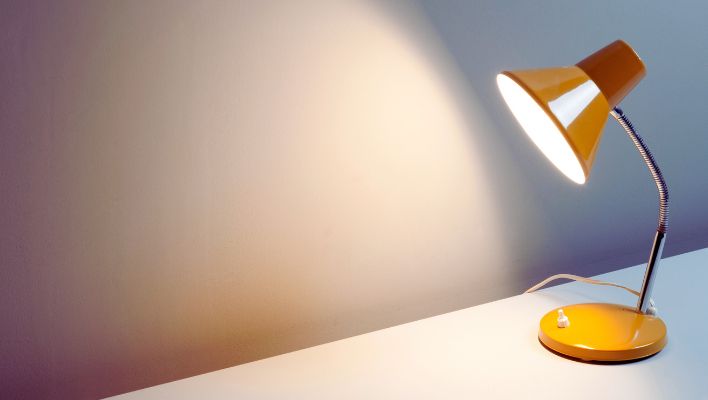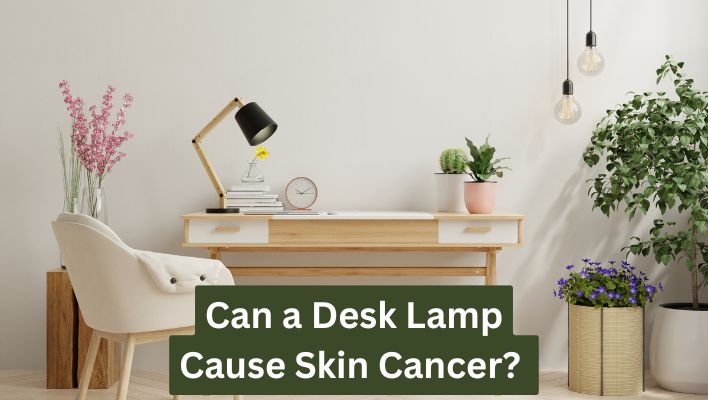Yes, a desk lamp can potentially cause skin cancer due to its exposure to ultraviolet (UV) radiation. UV radiation damages the DNA in skin cells, leading to mutations that can eventually result in skin cancer.
Desk lamps are commonly used in homes and offices to provide focused lighting for various tasks. However, concerns have been raised regarding the potential health risks associated with prolonged exposure to the light emitted by these lamps. One specific concern is whether a desk lamp can cause skin cancer.
Skin cancer is a serious condition that occurs when the DNA in skin cells is damaged by ultraviolet (UV) radiation. As such, it is important to understand the potential risks of using a desk lamp and take precautionary measures to protect our skin. We will explore the relationship between desk lamps and skin cancer, shedding light on the potential dangers and offering tips for minimizing the risk.
Table of Contents
Understanding The Different Types Of Radiation
Understanding the Different Types of Radiation emitted by desk lamps is essential when considering the potential risks of skin cancer. While desk lamps may seem harmless, it is important to be aware of the specific types of radiation they emit. This knowledge will empower us to make informed decisions about protecting our skin and reducing the risk of harmful effects. In this section, we will explore the differences between UVA, UVB, and UVC radiation and their potential impact on our skin.
Read Also: Are Standing Desk Converters Worth It?
Types Of Radiation Emitted By Desk Lamps
Desk lamps emit different types of radiation, some of which can have potential effects on our skin. Here are the main types:
- Visible light: This is the light that is visible to the human eye.
- Ultraviolet (UV) radiation: This type of radiation is invisible to the human eye and can be emitted by certain desk lamps. It is important to note that not all desk lamps emit UV radiation.
- Infrared radiation: This type of radiation is also not visible to the human eye and is often associated with heat. It is emitted by some desk lamps.
Differences Between Uva, Uvb, And Uvc Radiation
When it comes to UV radiation, it is important to understand the differences between UVA, UVB, and UVC radiation types:
| Radiation Type | Description |
|---|---|
| UVA | UVA radiation has longer wavelengths and can penetrate deeper into the skin. It is associated with skin aging and has been linked to an increased risk of certain types of skin cancer. |
| UVB | UVB radiation has shorter wavelengths and is responsible for sunburns. It can also penetrate the skin and is a major contributor to skin cancer. |
| UVC | UVC radiation has the shortest wavelengths and is the most harmful type of UV radiation. Fortunately, it is almost entirely absorbed by the Earth’s atmosphere and does not usually reach the surface. |
It’s important to note that not all desk lamps emit UV radiation, and even those that do may emit very low levels. Additionally, the time of exposure is a crucial factor in determining the potential risk of skin damage.
Now that we have a better understanding of the different types of radiation emitted by desk lamps, we can proceed to explore how these types of radiation may affect our skin and the potential risks of developing skin cancer.
The Potential Health Risks Of Desk Lamp Radiation

Can a desk lamp cause skin cancer? It’s a question that has gained attention in recent years, as more people spend long hours working under artificial lighting. While desk lamps are a staple for many who work or study at a desk, there is concern about the potential health risks associated with prolonged exposure to desk lamp radiation. Understanding these risks is crucial in making informed decisions about our workspace and overall well-being. In this article, we will examine the potential risks of excessive exposure to desk lamp radiation, with a particular focus on the link between UV radiation and skin cancer.
Examining The Potential Risks Of Excessive Exposure To Desk Lamp Radiation
When it comes to desk lamps, radiation is a term that can spark concern. But what exactly does it mean? Desk lamps emit a type of electromagnetic radiation known as visible light, which allows us to see the illuminated area. However, some types of desk lamps, such as halogen lamps and compact fluorescent lamps (CFLs), also emit ultraviolet (UV) radiation, which falls outside the visible light spectrum.
Although UV radiation is mainly associated with sunlight and tanning beds, it can also be emitted in small amounts by certain desk lamps. This raises the question of whether excessive exposure to desk lamp radiation, including UV radiation, can pose health risks.
Understanding The Link Between Uv Radiation And Skin Cancer
UV radiation is known to be a leading cause of various skin conditions, including skin cancer. When the skin is exposed to UV radiation, it can damage the DNA in skin cells, leading to mutations that can eventually result in cancerous growths. The more intense and prolonged the exposure to UV radiation, the higher the risk of developing skin cancer.
While the UV radiation emitted by desk lamps is generally small in comparison to sunlight, long-term exposure may still contribute to cumulative UV damage. This is especially true if the desk lamp is positioned close to the skin or if the exposure occurs over extended periods.
It is important to note that not all desk lamps emit UV radiation. LED lamps, for example, are generally considered safe in terms of UV emission. However, it is always advisable to check the specifications and choose lamps that are labeled as UV-free or specifically designed to minimize UV radiation.
Read Also: How Do You Say Desk in Spanish?
Additionally, individuals with sensitive skin or a history of skin cancer should take extra precautions to limit UV exposure, including minimizing exposure to any potential sources of UV radiation, such as desk lamps.
In conclusion, while desk lamps may contribute minimal UV radiation compared to direct sunlight, it is essential to be aware of the potential risks associated with prolonged exposure. By understanding the link between UV radiation and skin cancer, and making informed choices about the type of desk lamps we use, we can minimize the potential health risks and create a safer, healthier workspace.
Factors To Consider For Safe Desk Lamp Usage
When it comes to using a desk lamp, the safety of your skin should be a top priority. While it is well-known that prolonged exposure to the sun’s ultraviolet (UV) rays can cause skin cancer, you may be wondering if a desk lamp can have a similar effect. In this article, we will explore the factors to consider for safe desk lamp usage, including the importance of selecting the right type of desk lamp, positioning the desk lamp for optimal safety, and utilizing protective measures. By adhering to these guidelines, you can enjoy the benefits of a well-lit workspace without compromising your skin’s health.

Importance Of Selecting The Right Type Of Desk Lamp
When selecting a desk lamp, it is crucial to choose one that minimizes your exposure to harmful UV rays. LED lamps are a popular choice due to their energy efficiency and longer lifespan. Unlike traditional incandescent bulbs, LED lamps emit minimal UV radiation, reducing the risk of skin damage. Additionally, look for lamps labeled as “UV-free” or “UV-blocking” to further ensure your safety. By opting for these types of lamps, you can enjoy the benefits of adequate lighting without increasing your risk of skin cancer.
Positioning The Desk Lamp For Optimal Safety
The position of your desk lamp plays a significant role in minimizing skin exposure to UV rays. To avoid direct contact with the lamp’s light, position it behind you or to the side, rather than directly in front of you. This positioning will create a shadow effect, reducing the direct intensity of the light on your skin. Furthermore, consider the distance between your desk and the lamp. The recommended distance between your eyes and the lamp is approximately 16 to 24 inches, ensuring a comfortable and safe illumination for your workspace. By following these positioning guidelines, you can effectively mitigate the risk of skin damage caused by your desk lamp.
Read Also: How to Fix a Wobbly Desk
Utilizing Protective Measures, Such As Uv-blocking Screens Or Bulbs
In addition to choosing the right type of desk lamp and positioning it appropriately, you can further enhance your safety by utilizing protective measures. UV-blocking screens, commonly used for computer monitors, are available for desk lamps as well. These screens act as a barrier, reducing the UV radiation emitted by the lamp and shielding your skin from potential harm. Furthermore, you can opt for UV-blocking bulbs, specifically designed to filter out harmful UV rays. These bulbs provide a safe and productive workspace environment, allowing you to work comfortably without worrying about the risks to your skin. By incorporating these protective measures into your desk lamp setup, you can prioritize your skin’s well-being while maintaining optimal lighting conditions.
Tips For Protecting Your Skin
A desk lamp alone cannot cause skin cancer, but exposure to ultraviolet (UV) radiation from certain types of desk lamps can increase the risk of skin damage, including sunburn and premature aging. It is important to protect your skin by using sunscreen, wearing protective clothing, and limiting your exposure to UV light.
Ensuring Proper Exposure Time To Minimize Risk
A desk lamp may not be the first thing that comes to mind when you think of skin cancer. However, it’s important to understand that certain types of desk lamps emit UV radiation, which can increase the risk of skin cancer over time.
One of the key factors in minimizing this risk is to ensure proper exposure time to UV radiation. It’s recommended to limit your exposure to UV radiation from desk lamps to short periods of time. Avoid prolonged exposure, especially if you have fair or sensitive skin.
To determine the appropriate exposure time, you can refer to the lamp’s documentation or consult with a dermatologist. They will be able to provide you with specific guidelines based on the lamp’s intensity and your skin type.
Understanding The Importance Of Sunscreen And Protective Clothing
While limiting exposure time is crucial, it’s also important to layer your skin with additional protection. Two key elements in this regard are sunscreen and protective clothing.
Sunscreen should be an essential part of your daily routine, regardless of whether you’re going outdoors or staying indoors. Look for a broad-spectrum sunscreen with a high SPF (sun protection factor) to shield your skin from harmful UV radiation.
In addition to sunscreen, wearing protective clothing can further reduce your risk of skin cancer. Opt for long-sleeved shirts, pants, and wide-brimmed hats to provide extra coverage for your skin. Lightweight and breathable fabrics with a tight weave are ideal for preventing UV rays from reaching your skin.
Adopting Healthy Habits To Enhance Overall Skin Health
Protecting your skin from the potential harm of desk lamps is not only about minimizing the risk of skin cancer but also about enhancing overall skin health. In addition to exposure time and protective measures, adopting healthy habits can make a significant difference in maintaining the well-being of your skin.
First and foremost, stay hydrated by drinking an adequate amount of water throughout the day. Hydration helps keep your skin moisturized and healthy. Additionally, incorporating a balanced diet rich in fruits, vegetables, and antioxidants can contribute to skin health and boost its natural defenses.
Read Also: How Deep Should a Computer Desk Be
Another essential habit is to moisturize your skin regularly. Use a moisturizer that suits your skin type to prevent dryness and maintain its elasticity. Don’t forget to pay special attention to areas exposed to desk lamp radiation, such as your face and hands.
Lastly, avoid excessive sun exposure during peak hours and consider using desk lamps with built-in UV filters to further reduce the risks associated with UV radiation.
Creating A Safe And Well-lit Workspace

When it comes to designing a workspace, the health and well-being of the occupants should always be a top priority. One important aspect to consider is the lighting setup in the office, specifically the use of desk lamps. In recent years, concerns have arisen regarding whether desk lamps can cause skin cancer due to their exposure to radiation. While the potential risk is relatively low, it is still essential to take precautions and create a safe and well-lit environment. In this article, we will explore the different ways to achieve this, emphasizing the integration of natural light with artificial lighting, utilizing desk lamp alternatives to reduce radiation exposure, and designing an ergonomic workspace that prioritizes safety and comfort.
Integrating Natural Light With Artificial Lighting
When planning out your workspace, an ideal approach is to integrate natural light with artificial lighting. Natural light not only helps create a more pleasant working environment, but it also provides various health benefits. Exposure to natural light throughout the day helps regulate our circadian rhythm, boosting productivity and overall well-being.
To maximize the benefits of natural light, consider positioning your desk near a window or skylight. This will allow you to enjoy the benefits of natural light while working. Additionally, you can install adjustable blinds or curtains to control the amount of sunlight entering the workspace, minimizing glare and ensuring a comfortable level of brightness.
To complement natural light, artificial lighting should be strategically placed to provide adequate illumination. Supplementing natural light with desk lamps or overhead lighting can help maintain consistent brightness throughout the day, preventing eye strain and fatigue.
Utilizing Desk Lamp Alternatives To Reduce Radiation Exposure
While desk lamps are convenient for task lighting, concerns have been raised regarding the potential radiation exposure they may pose. Radiation emitted by desk lamps is generally low and does not pose a significant risk. However, if you are still concerned about radiation exposure, there are alternative lighting options you can consider.
LED desk lamps are an excellent alternative to traditional incandescent or fluorescent lamps. LED lamps produce very minimal amounts of radiation, making them a safer choice to illuminate your workspace. They are energy-efficient, long-lasting, and come in various designs to suit your aesthetic preferences.
Read Also: How Deep Should a Desk Be?
Another option is to utilize natural light as much as possible and minimize the use of desk lamps. Relying on natural light during the daytime can significantly reduce your exposure to artificial light sources and potential radiation. This approach not only minimizes health concerns but also helps save on energy consumption.
Designing An Ergonomic Workspace That Prioritizes Safety And Comfort
In addition to lighting, the overall design of your workspace plays a crucial role in ensuring safety and comfort. Ergonomics should be a key consideration when setting up your desk and chair. An ergonomic chair with proper back support and adjustable height can prevent strain on your neck, back, and shoulders, reducing the risk of musculoskeletal disorders.
Furthermore, the desk height should be suitable for your posture and typing position. A desk that allows you to maintain a natural and comfortable position will aid in preventing repetitive strain injuries.
Organizing your workspace efficiently is also important. Keeping frequently used items within close reach and decluttering your desk helps promote productivity and minimizes the risk of accidents or injuries.
Lastly, ensure there is proper ventilation and air circulation in your workspace. Good air quality can enhance overall well-being and prevent the accumulation of pollutants that may arise from inadequate ventilation.
Frequently Asked Questions Of Can A Desk Lamp Cause Skin Cancer
Can Light From A Bulb Cause Skin Cancer?
No, light from a bulb does not cause skin cancer. Skin cancer is mainly caused by exposure to ultraviolet (UV) radiation from the sun and tanning beds. Bulb light emits minimal UV radiation and is safe for skin. Always take precautions when exposed to sunlight.
Is Lamp Light Bad For Skin?
Yes, lamp light can be harmful to the skin due to its blue light emissions. Blue light can penetrate the skin and cause oxidative stress, leading to premature aging and potential damage. It is important to protect your skin by using sunscreen and limiting exposure to lamp light.
Can Office Lights Damage Skin?
Yes, prolonged exposure to office lights can damage the skin due to harmful UV rays emitted by certain types of light bulbs. Skin may become dry, pigmented, and prone to premature aging. It is important to use light bulbs with lower UV radiation levels and protect the skin by using sunscreen and moisturizers.
Does Led Light Increase Risk Of Skin Cancer?
No, LED lights do not increase the risk of skin cancer. LED light emits low levels of UV radiation, which is not harmful to the skin. Unlike other sources of light, such as the sun or tanning beds, LED lights are considered safe for everyday use.
Conclusion
To sum up, while there is no direct evidence linking desk lamps to skin cancer, it is advisable to take precautions when using them. Limiting exposure to intense light, choosing LED lamps with low UV rays, and maintaining a safe distance can reduce any potential harm.
Prioritizing skin protection through sunscreen and ensuring overall well-being by incorporating breaks from long hours of desk work are essential. Stay informed and make informed decisions to prioritize your health and safety.



